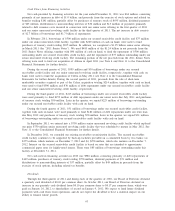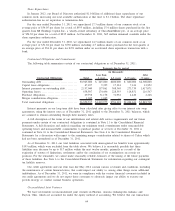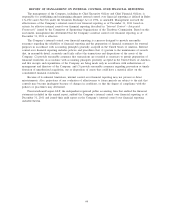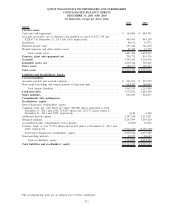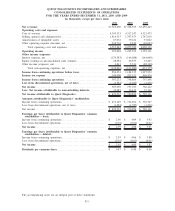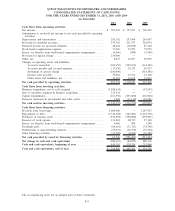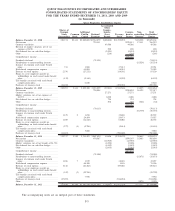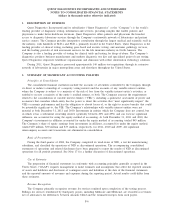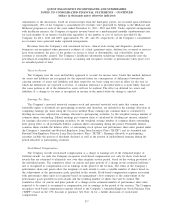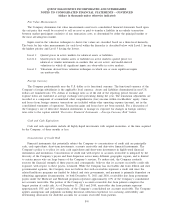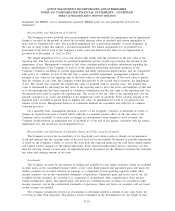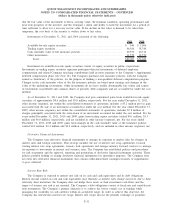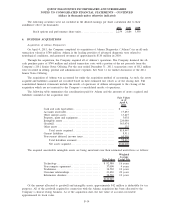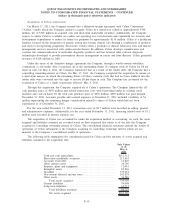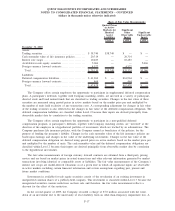Quest Diagnostics 2011 Annual Report Download - page 79
Download and view the complete annual report
Please find page 79 of the 2011 Quest Diagnostics annual report below. You can navigate through the pages in the report by either clicking on the pages listed below, or by using the keyword search tool below to find specific information within the annual report.Adjustments to the allowances, based on actual receipts from the third-party payers, are recorded upon settlement.
Approximately 18% of the Company’s consolidated net revenues were generated by billings to the Medicare and
Medicaid programs in each of the years ended December 31, 2011, 2010 and 2009. Under capitated arrangements
with healthcare insurers, the Company recognizes revenue based on a predetermined monthly reimbursement rate
for each member of an insurer’s health plan regardless of the number or cost of services provided by the
Company. In 2011, 2010 and 2009, approximately 3%, 4%, and 4%, respectively, of the Company’s consolidated
net revenues were generated under capitated arrangements.
Revenues from the Company’s risk assessment services, clinical trials testing and diagnostics products
businesses are recognized when persuasive evidence of a final agreement exists; delivery has occurred or services
have been rendered; the price of the product or service is fixed or determinable; and collectibility from the
customer is reasonably assured. The Company’s healthcare information technology business primarily uses the
percentage-of-completion method of contract accounting and recognizes revenue as performance takes place over
an extended period of time.
Taxes on Income
The Company uses the asset and liability approach to account for income taxes. Under this method, deferred
tax assets and liabilities are recognized for the expected future tax consequences of differences between the
carrying amounts of assets and liabilities and their respective tax bases using tax rates in effect for the year in
which the differences are expected to reverse. A valuation allowance is provided when it is more likely than not
that some portion or all of the deferred tax assets will not be realized. The effect on deferred tax assets and
liabilities of a change in tax rates is recognized in income in the period when the change is enacted.
Earnings Per Share
The Company’s unvested restricted common stock and unvested restricted stock units that contain non-
forfeitable rights to dividends are participating securities and, therefore, are included in the earnings allocation in
computing earnings per share using the two-class method. Basic earnings per common share is calculated by
dividing net income, adjusted for earnings allocated to participating securities, by the weighted average number of
common shares outstanding. Diluted earnings per common share is calculated by dividing net income, adjusted
for earnings allocated to participating securities, by the weighted average number of common shares outstanding
after giving effect to all potentially dilutive common shares outstanding during the period. Potentially dilutive
common shares include the dilutive effect of outstanding stock options and performance share units granted under
the Company’s Amended and Restated Employee Long-Term Incentive Plan (“ELTIP”) and its Amended and
Restated Non-Employee Director Long-Term Incentive Plan (“DLTIP”). Earnings allocable to participating
securities include the portion of dividends declared as well as the portion of undistributed earnings during the
period allocable to participating securities.
Stock-Based Compensation
The Company records stock-based compensation as a charge to earnings net of the estimated impact of
forfeited awards. As such, the Company recognizes stock-based compensation cost only for those stock-based
awards that are estimated to ultimately vest over their requisite service period, based on the vesting provisions of
the individual grants. The cumulative effect on current and prior periods of a change in the estimated forfeiture
rate is recognized as compensation cost in earnings in the period of the revision. The terms of the Company’s
performance share unit grants allow the recipients of such awards to earn a variable number of shares based on
the achievement of the performance goals specified in the awards. Stock-based compensation expense associated
with performance share units is recognized based on management’s best estimates of the achievement of the
performance goals specified in such awards and the resulting number of shares that will be earned. The
cumulative effect on current and prior periods of a change in the estimated number of performance share units
expected to be earned is recognized as compensation cost in earnings in the period of the revision. The Company
recognizes stock-based compensation expense related to the Company’s Amended Employee Stock Purchase Plan
(“ESPP”) based on the 15% discount at purchase. See Note 14 for a further discussion of stock-based
compensation.
F-7
QUEST DIAGNOSTICS INCORPORATED AND SUBSIDIARIES
NOTES TO CONSOLIDATED FINANCIAL STATEMENTS - CONTINUED
(dollars in thousands unless otherwise indicated)


